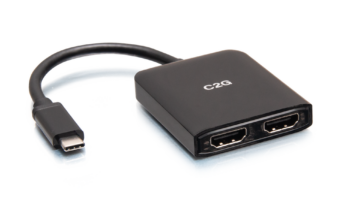A consortium of consumer electronics manufacturers and movie studios announced the formation of a working group to define a new digital interface solution for digital television devices.
The group, which includes Hitachi, Matsushita, Philips, Silicon Image, Sony, Thomson and Toshiba, plus Fox and Universal studios, will propose an enhanced interface based on the basic Digital Visual Interface (DVI) connection for uncompressed digital broadband video. The new version, however, has been expanded to include multichannel Dolby Digital audio signals.
Supporters say the new interface, called the High Definition Multimedia Interface (HDMI), is a single, one-way, high-speed connection that would carry full-bandwidth digital video and audio from set-top boxes or digital video recorders to TV sets. It can be used to deliver a very high-quality audio and video image from consumer electronics devices directly to digital video displays.
By combining both audio and video, the system will eliminate numerous separate cable connections now required for digital video systems.
The basic DVI spec and accompanying High-bandwidth Digital Copy Protection (HDCP) system had been developed in part by Intel, while Silicon Image has championed the addition of audio capability in a proposal that had been referred to as DVI-CE among other code names. Silicon Image has also coordinated the formation of the HDMI founding members working group.
Beyond working group members, Silicon Image spokesperson Kristen Fuller said the group “has the support” of numerous other consumer electronics and computer companies, cable and satellite providers and most of the Hollywood studios.
She added that HDMI members are not advocating the use of HDMI to the exclusion of other digital networking connections, such as IEEE-1394. Rather, she said, most members expect that both the HDMI and IEEE-1394 interfaces will be used in many future devices.
Because HDMI is designed to carry uncompressed digital signals in a one-way wired connection, it is most ideally suited as the last connection between a digital television display and the second to last component in a digital home network chain, HDMI proponents say. The IEEE-1394 two-way connection (among other possible alternatives), which carries MPEG 2 video and other digitally compressed signals, would be appropriate for interconnecting other components in future home network systems, she said.
Proposals call for the HDMI connector to be physically smaller than current DVI connectors. However, when used with an adapter, the video portion of the HDMI signal will be backward compatible with DVI-enabled devices. This means that current DVI displays that are on the market or coming later this year will be able to connect to the new system. (Audio signals would have to be supplied through separate connections, however).
The early HDMI spec allows for a 5Gigabyte per second data rate, which is more than double the bandwidth required for an uncompressed 1080i high definition movie with Dolby Digital surround sound (2.2Gbps). The extra bandwidth could even accommodate 1080p signals (the ultimate HDTV format) some day.
Both DVI and HDMI connections include a copy protection system called the High-bandwidth Digital Content Protection (HDCP) system. Fuller said most Hollywood studios have expressed approval for the basic DVI with HDCP system, although only Fox and Universal have formally endorsed it.
This year’s time line for the working group eventually calls for the demonstration of prototype products at CES 2003.
If all goes smoothly, the first HDMI enabled devices could reach market sometime next year, the group said. However, before Hollywood agrees to support any digital connection a number of issues must still be addressed. These include establishing rules covering what home users will and will not be permitted to do with the digital copy righted content, and how much control Hollywood will have over that content in the home.
Opponents of DVI, including Bob Perry, Mitsubishi marketing VP, have argued that the uncompressed high-bandwidth nature of DVI signals makes them virtually impossible to record with current equipment, which could enable studios to effectively eliminate consumer’s fair use rights. He has said he fears studios looking to prevent home copying of any kind (fair use or otherwise), will release high definition programming with instructions that it be transmitted only over DVI (or HDMI) interfaces. This would effectively prevent the use of digital video recorders, PVRs and even some non-HDMI/DVI television displays.
However, Thomson spokesman Dave Arland said many companies plan to use HDMI in conjunction with other connectors (typically IEEE-1394 with DTCP copy protection) to handle fair use recording issues. Thomson is adding HDMI-compatible DVI connections to all of its HDTV monitors and sets this year. The company’s HDTV sets will also carry IEEE-1394 connections, he said.
One fear among HDTV owners is that the introduction of digital interfaces will eventually lead to the elimination of analog HD component video connections that are currently the most commonly used connection between DTV set-top boxes, DVD players and DTV displays.
Arland said “we have to go into this with our eyes open” to the fact that many early HDTV supporters may not have a means of connecting to devices that carry only digital interfaces.
“We will be maintaining analog component video inputs as well [as HDMI and 1394], at least for a time,” said Arland. “We are just in the beginning of this transition for analog to digital interfaces.”
However, he acknowledged that the decision of which interfaces will eventually be supported with digital signals ultimately lies with the studios.
Peter Fannon, Matsushita’s technology policy and regulatory affairs VP, added, “The good news is that there is such a clear set of principles and the opportunities are so apparent in this larger move to digital, that we all hope real solutions can be reached soon and they will all be widely vetted in public.”













